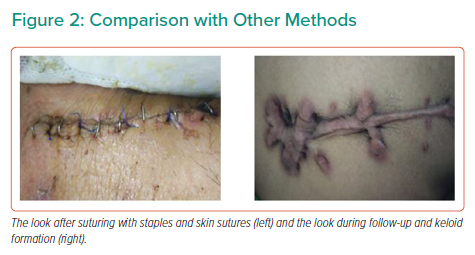Aim: To present one operator’s 4-year experience on the safety of pocket closure using single absorbable subcuticular suture Vicryl 2-0 at various armed forces and civilian centres.
Methods: This is a single operator observational study. Between January 2017 and December 2020, a total of 365 patients underwent device implantation for various indications at different hospital of armed forces and civil by the author.
Results: All 365 cases underwent pocket closure using three layers of single continuous absorbable subcuticular suture with Vicryl 2-0 in 364 (99.7%) and Monocryl 2-0 in 1 (0.27%) patient. CIED distribution was: AICD single chamber-34 (24.5%), PPI single chamber-131 (35.9%), AICD dual chamber-13 (3.6%), PPI dual chamber-130 (35.6%), CRT P/D-3 (0.8%), AICD PGR-9 (2.5%), CRT PGR-4 (1.1%) and PPI PGR 41 (11.2%). There were 52 (14.2%) patients on dual antiplatelet therapy (DAPT) and nine (2.46%) patients on oral anticoagulants. Ages ranged from 4 years to 92 years (average age 66 ± 1.6 years). 128 patients (35%) were female and 227 (65%) were male. 124 patients (33.9%) were diabetic. All patients received minimum 5 days in-hospital IV antibiotics and 96.7% patients were discharged on day 5 post-op. Average in-hospital stay was 5.7 days.
Twelve (3.28%) patients developed pocket site infection with no mortality. In four patients, infection was superficial not communicating with pocket. It healed with prolonged antibiotics for 1 extra week. Eight (66.7%) of these patients underwent device re-implantation subpectoral on same side with help of reconstructive surgeon and five (62.5%) devices were salvaged. Thus three (0.82%) patients required device explantation and procedure completed from contralateral side same day. All three patients were females in physically active age group. Two (66.67%) of these were diabetic, while one (33.33%) was on DAPT. In comparison only one patient who underwent pocket closure using Moncryl 2-0 was explanted.
Conclusion: Pocket closure using three layers of single continuous absorbable subcuticular suture Vicryl 2-0 has been found to be very safe and effective modality for pocket closure and also helps in reducing pocket infection. In our experience after using this suture device, explantation rate was only 0.55% and device healing success rate was 99.45%. It is convenient for the patients too, as total duration of in-hospital stay as well as post discharge visits are reduced significantly. It also gives an aesthetic look which is especially appealing in young females. Monocryl 2-0 has not been found to be a good alternative as device explantation rate using this suture was 100%. We also found that device salvage therapy using subpectoral pocket and negative pressure wound therapy by reconstructive surgeons has shown a success rate of 62.5%.











